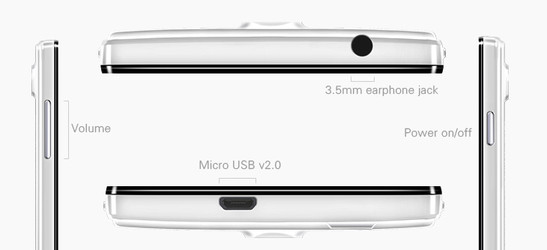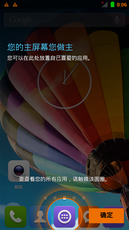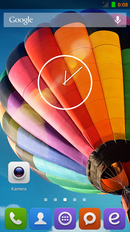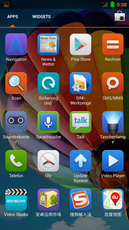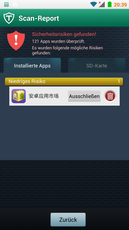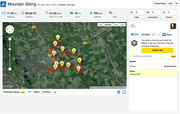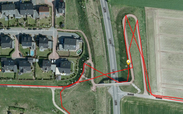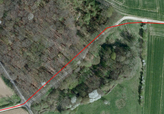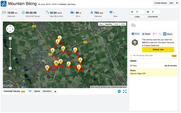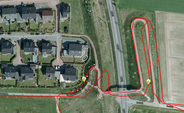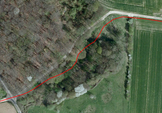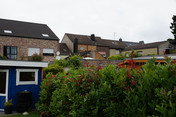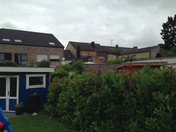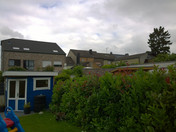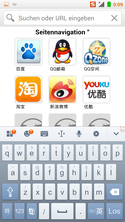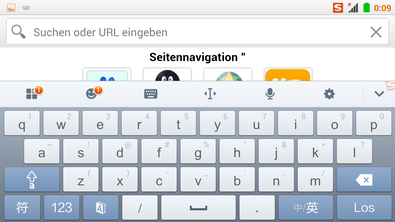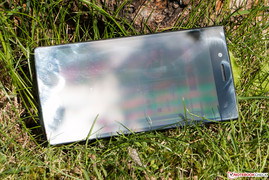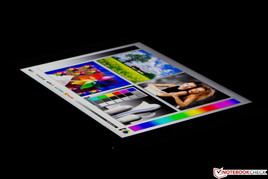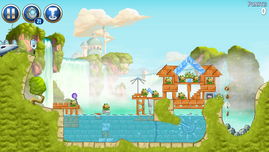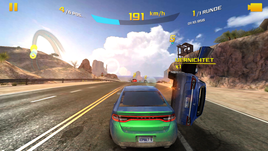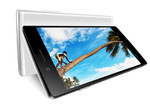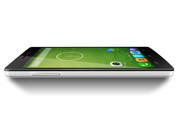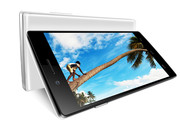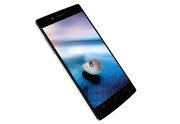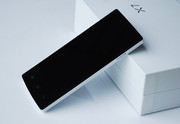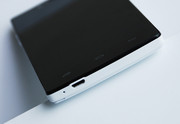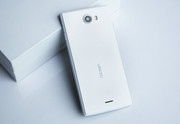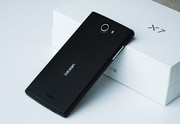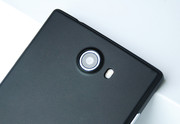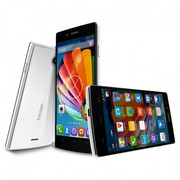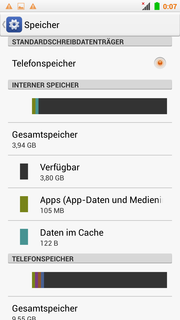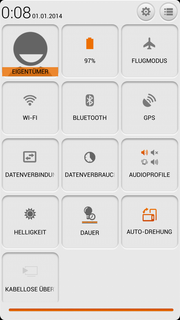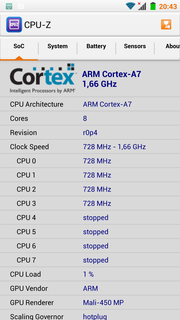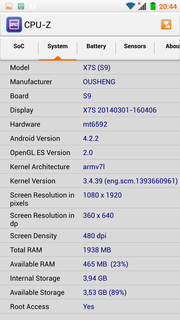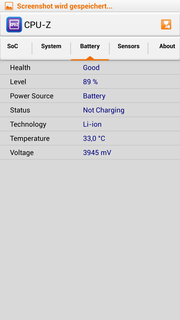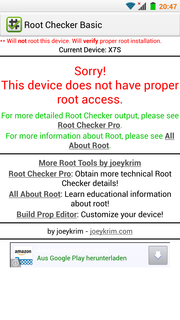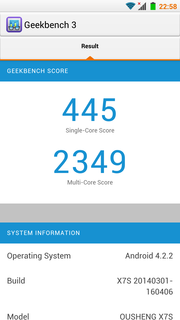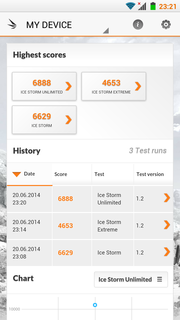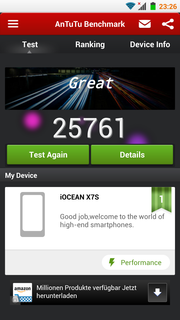iOcean X7S Smartphone Review

For the original German review, see here.
The iOcean X7S is a reworked version of the X7. The predecessor's biggest problems were its small storage space and difficulty installing individual applications. Additionally, the German translation of the menu was incomplete, the high-resolution camera only took mediocre pictures, and the manufacturing quality left something to be desired. The X7S' fundamental design remains the same, but iOcean expanded the storage and switched out the display -- and threw in a bona fide eight-core processor from MediaTek.
Based on its specs, the iOcean smartphone lines up against competitors like the Zopo ZP1000, the Wiko Highway and the Alcatel One Touch Idol+, though our review device is considerably cheaper.
Case
In terms of its case, the iOcean X7S is exactly like its predecessor: Its form and measurements are identical. The only difference is that the new smartphone is a little lighter, now weighing only 135 grams (~0.3 lbs).
The X7S' material composition and manufacturing quality are more or less average. However, with its rubberized surface, the plastic iOcean used has a good grip to it and feels nice in your hands. The smartphone resists twisting quite well; we could not get more than a negligible creaking sound out of the device. However, the X7S proves to be very sensitive to pressure. Strong pressure applied to the back side generates waves on the display, and even pressing hard against the panel while entering input produces little ripples on the screen.
A notch on the back of the smartphone helps the user to simply remove the back cover. Once inside, both SIM slots, the memory card slot and the battery are all accessible. The piece of foam iOcean stuck to the inside of the back cover to hold the second SIM card in place is a little tacky.
Connectivity
The iOcean X7S' USB 2.0 port is said to support OTG. Unfortunately, we could not verify this, as the smartphone recognized neither the USB stick nor the mouse in our tests. The card reader can read micro SD cards up to 32 GB in size. The function App2SD was supported for the apps we used in our tests.
The two SIM slots are easy to access. The first slot accepts micro-SIM cards and supports 3G, while the second slot is a mini-SIM slot and only transmits over 2G networks.
Software
The slightly outdated Google Android 4.2.2 serves as the smartphone's operating system. iOcean has jumped on the proprietary user interface (UI) bandwagon and created quite the bright scheme. As was true of the predecessor, the interface's translation into German has some holes in it; some system dialogs are only displayed in English, and in some places there are even a few Chinese fragments left over. In the same vein, the system comes with preinstalled Chinese apps, though these can be easily uninstalled. Only one app (Sogou.com) reinstalls itself after the system is restarted.
Those who wish to use an alternative browser may encounter some problems. Firefox forced us to reboot the entire system when we wanted to watch a video on YouTube.
Communication & GPS
In terms of communication, not much has changed since the iOcean X7S' predecessor. The WLAN module only supports the IEEE standards 802.11 b/g/n and only transmits over the 2.4 GHz band. However, the wireless module's reception range and connection quality are not as good as its predecessor's. Even directly next to the router (Fritz!Box 6360), the attenuation was -53 dBm. 20 meters from the router the smartphone reached -80 dBm, and the browser was no longer able to load webpages.
The smartphone's mobile reception proved to be below average as well. The device does support quad-band GSM, but here we registered comparably high attenuations of up to -111 dBm. Only the first SIM slot supports dual-band HSPA, enabling the phone to download at rates of up to 21 MBit/s. The device could easily have supported a broader range of frequencies here. Neither LTE nor NFC are available on this smartphone. Bluetooth 4.0, however, is on board and functions flawlessly.
The aGPS receiver operates very slowly. Even outdoors, the receiver takes a comparably long time to communicate with enough satellites to position itself. As the GPS Test app shows, the GPS module's reception is not especially good. Nevertheless, even indoors the receiver can determine its location given several minutes to search the skies.
Compared with the Garmin Edge 500 GPS we use on our bike as a reference, the iOcean X7S does not achieve incredible results, but the positioning information our test device provides is still workable.
Telephone Function and Speech Quality
Visually, the iOcean X7S' telephone app looks very clean and has only changed a little since the predecessor model. The speech quality is quite good. In our tests in quiet environments, our speech was always easy to understand. Unfortunately, there is no second microphone to help the smartphone cancel out background noise. We also understood our partner on the other side of the line without a problem. However, the two speakers over-modulated when reproducing high tones, leaving them sounding rather shrill. The manufacturer does not include a headset with this model.
Cameras
The iOcean X7S has two cameras. The Chinese company amped up the front camera, and at up to 5 MP (2560x1920 pixels), the lens is supposed to be especially good for taking selfies. Truth be told, the camera does produce respectable photos. The colors look natural, though the images are a little fuzzy. Finer details especially can blur away easily.
The main camera on the backside of the device has a 13 MP sensor (4160x3120 pixels; 4:3) that offers an auto focus and supports HDR. The lens only has to be a minimum of 5 centimeters from the subject to take a shot.
The main camera's photos are somewhat pale and slightly overexposed. In addition, the images are less and less sharp as you move towards the edges. On panorama shots, the details are a little bit spongy. In unfavorable lighting situations, the camera quickly ends up out of its element, and its photos are plagued with image noise. However, the photo LED makes it possible to take acceptable shots in such environments. iOcean advertises this camera module as on par with professional cameras, which is simply untrue: The component's image quality is far beneath that of professional devices. Both of the iOcean X7S' cameras can record videos in Full HD.
Accessories and Warranty
The iOcean X7S comes accompanied by a modular power supply with a nominal power rating of 5 Watts (5V, 1A) and a USB cable. During the ordering process, the buyer can opt to purchase a screen protector (5 Euros; ~$7) and/or a stronger battery (3000 mAh with a case, 20 Euros; ~$27), and/or root the system (5 Euros, ~$7).
The manufacturer outfits the device with a 12-month warranty, while the accessories and batteries come with a 6-month warranty. Since the smartphone is distributed from Germany, if the device is purchased in Germany, the delivery time can be quite short. Also nice: There is no import tax, and every customer within the European Union can enjoy the mandatory two-year retailer's warranty.
Input Devices & Operation
The iOcean X7S is equipped with a 5-inch capacitive touchscreen that recognizes up to five fingers of input simultaneously. The smartphone reliably recognizes and translates input entered along the edges of the screen. Fingers glide easily across the display.
iOcean adapted the virtual keyboard quite well to suit the smartphone. Interestingly, the keyboard has an additional toolbar. Unfortunately, the keyboard is not fully translated out of Chinese, which means most native speakers of German or English will have to guess at the meaning of the symbols. Also, the comma is missing in the standard layout, which is a bit of a time-guzzler when typing messages.
Display
Compared to the predecessor of the iOcean X7S, the size and resolution of the display have not changed: It is still 5-inches and has a resolution of 1920x1080 pixels. That corresponds to an aspect ratio of 16:9 and a pixel density of 441 ppi. However, the IPS panel now has LTPS, which constitutes an advancement.
The display brightness is now somewhat lower and reaches a maximum of only 319 cd/m². However, at a 91% similarity across the screen, the display's brightness distribution is very even. We could not find any spots where the light pooled.
| |||||||||||||||||||||||||
Brightness Distribution: 91 %
Center on Battery: 313 cd/m²
Contrast: 497:1 (Black: 0.63 cd/m²)
ΔE ColorChecker Calman: 7.38 | ∀{0.5-29.43 Ø4.78}
ΔE Greyscale Calman: 7.73 | ∀{0.09-98 Ø5}
Gamma: 2.21
CCT: 8205 K
The black value worsened slightly as well and now comes to 0.63 cd/m². As a result of both this and the lower brightness, the panel's contrast ratio is now a weaker 497:1.
The display's color accuracy is on a similar plane. The colors white, red and cyan deviate substantially from the target values. Parts of the grayscale also reach DeltaE deviations of over 10, which give the display a slight blue cast. In practice, however, the display content looks very colorful, and only a trained eye would notice that the colors are ever so slightly off.
Outdoors, the panel's mediocre brightness and weaker contrast are certainly noticeable. In a nice shady spot, however, these shortcomings will not be an issue. But under direct sunlight the screen content on the iOcean X7S' reflective display is hardly visible.
In the realm of viewing-angle stability, the smartphone profits from its new LTPS technology. Even from extremely flat angles, the display content looks just as it ought to. Nor is the panel haunted by a ghost-effect. The display does not even lose much brightness as the viewing angle widens -- the dimming is only noticeable with careful observation.
Performance
The iOcean X7S runs on a MediaTek MT6592. Each core of the octa-core processor has a clock speed of up to 1.7 GHz. The SoC has 2 GB of working memory at its command. The integrated ARM Mali-450 MP4 takes care of graphics tasks.
The smartphone does quite well in our benchmarks, securing a spot among the upper-middle class. Only competitors with the same processor run faster. The Wiko Highway's advantage lies above all in its extra 300 MHz of clock speed. The Alcatel Idol X+, however, achieves better results even with the same number of megahertz. The Alcatel device probably cools itself more effectively and therefore does not have to deal with a loss in performance.
The storage device's speed is quite good as well. Only in the sequential read test does all the competition surpass our review device. The system can browse the web quickly.
| AnTuTu v4 - Total Score (sort by value) | |
| iOcean X7S | |
| Huawei Ascend G700 | |
| Google Nexus 5 | |
| Zopo ZP1000 | |
| Wiko Highway | |
| Geekbench 3 | |
| 32 Bit Single-Core Score (sort by value) | |
| iOcean X7S | |
| Huawei Ascend G700 | |
| Google Nexus 5 | |
| Zopo ZP1000 | |
| Wiko Highway | |
| Alcatel One Touch Idol X+ | |
| 32 Bit Multi-Core Score (sort by value) | |
| iOcean X7S | |
| Huawei Ascend G700 | |
| Google Nexus 5 | |
| Zopo ZP1000 | |
| Wiko Highway | |
| Alcatel One Touch Idol X+ | |
| 3DMark | |
| 1280x720 Ice Storm Standard Score (sort by value) | |
| iOcean X7S | |
| Huawei Ascend G700 | |
| Zopo ZP1000 | |
| Wiko Highway | |
| Alcatel One Touch Idol X+ | |
| 1280x720 Ice Storm Standard Graphics (sort by value) | |
| iOcean X7S | |
| Huawei Ascend G700 | |
| Zopo ZP1000 | |
| Wiko Highway | |
| Alcatel One Touch Idol X+ | |
| 1280x720 Ice Storm Standard Physics (sort by value) | |
| iOcean X7S | |
| Huawei Ascend G700 | |
| Zopo ZP1000 | |
| Wiko Highway | |
| Alcatel One Touch Idol X+ | |
| Peacekeeper - --- (sort by value) | |
| iOcean X7S | |
| iOcean X7 | |
| Huawei Ascend G700 | |
| Google Nexus 5 | |
| Zopo ZP1000 | |
| Wiko Highway | |
| Alcatel One Touch Idol X+ | |
| Octane V2 - Total Score (sort by value) | |
| iOcean X7S | |
| Google Nexus 5 | |
| Google Nexus 5 | |
| Wiko Highway | |
Games
The graphics unit at work in the iOcean X7S, the ARM Mali-450 MP4, provides enough performance power for most games in the Play Store. However, those who love to play games and play a lot might become easily disillusioned with the smartphone, as OpenGL ES 3.0 is not supported, and not all games can be played at high resolution and high details. For casual gamers the gaming performance our review device offers is more than sufficient.
Emissions
The iOcean X7S goes about its work in total silence. Unfortunately, this is not quite true of the power supply, which emits a high-frequency tone as it charges the smartphone. This is especially bothersome in quiet environments. For this reason, the power supply should not be used to charge the smartphone in a bedroom.
Temperature
The iOcean X7S' surface temperatures are considerably higher than its predecessor's (max. 37.9 °C; 100.22 °F). Even just in idle mode, our test device grew warm to the touch, reaching temperatures of up to 35.5 °C (95.9 °F).
Under load, which we simulate with the help of the app Stability Test (both the CPU and GPU are under load), the smartphone hit temperatures of up to 41.9 °C (107.42 °F). The Idol X+ (max. 38.0 °C; 100.4 °F) and the Zopo ZP1000 (max. 37.5 °C; 99.5 °F) remain substantially cooler. Even so, the iOcean X7S never grows disconcertingly hot, nor is it ever uncomfortable to hold.
(±) The maximum temperature on the upper side is 41 °C / 106 F, compared to the average of 35.2 °C / 95 F, ranging from 21.9 to 247 °C for the class Smartphone.
(±) The bottom heats up to a maximum of 41.9 °C / 107 F, compared to the average of 34 °C / 93 F
(±) In idle usage, the average temperature for the upper side is 32.3 °C / 90 F, compared to the device average of 32.9 °C / 91 F.
Speakers
The mono speaker on the back side of the iOcean X7S can be very loud. The sound it produces is by no means marvelous -- there is hardly any bass, and mid-tones are shallow too. High tones sound tinny and slightly over-modulated. Those who enjoy listening to music are better off connecting an external speaker or headphones. Even so, the sound quality the smartphone's speaker offers is good enough for the occasional YouTube video and the like. The audio jack functions quite well and delivers audio content without any disturbances.
Energy Management
Power Consumption
The iOcean X7S' energy consumptions rates have substantially improved since its predecessor, especially in standby mode and when the device is turned off. There is no longer anything to criticize here. In idle mode, the smartphone's energy use is on par with the competitors. Only the ZP1000 (1.1-1.8 W) needs slightly less power, but its display also has a smaller HD resolution. The X7S' energy consumption rates under load are completely acceptable and normal for a device with these components.
However, with a nominal power rating of 5 Watts, the power supply barely provides enough power to keep up with the smartphone's energy use under load.
| Off / Standby | |
| Idle | |
| Load |
|
Key:
min: | |
Battery Life
Though the iOcean X7S's energy consumption rates are higher than its predecessor's, our review device has the same 2000 mAh (7.4 Wh, 3.7 V) lithium-polymer battery as its older sibling. As a result, the optional 3000 mAh battery seems to be a worthwhile investment. However, the alternative case for the bigger battery increases the size of the smartphone. In addition, the battery and case do not appear to be particularly well affixed to each other.
In our surfing over WLAN test, which is designed to simulate practical, everyday use, we set the display brightness to around 150 cd/m² and run a script in the browser that loads a new webpage every 40 seconds. The X7S just barely crosses the 5-hour mark. This not a good runtime. Even with less use, fully charged the smartphone will not last to the end of the day without needing to connect to a power outlet. With the bigger battery, the device's runtime in the same scenario comes to about 8 hours.
Verdict
The iOcean X7S corrects some of its predecessor's mistakes, but it also makes new blunders. Considering the smartphone's price, its speedy processor and colorful Full HD display certainly make it look enticing. The device's speech quality is also quite respectable, and its ample storage space and App2SD support make a good impression.
Unfortunately, the battery life leaves something to be desired. Here we would like to have seen a more powerful battery and better energy efficiency. Because the alternative case for the optional 3000 mAh battery is not very stable, we cannot recommend it as a solution to this problem. Also, the dual-SIM device does not cover many frequencies, data transfer is a little slow, and there is no LTE to fall back on.
The smartphone also loses a percentage point for the problems we encountered with individual apps -- like the Firefox browser -- and the fact that parts of its menu and some keys were left untranslated.
We would also like to have seen a current version of Android, as Google Android 4.2.2 does not support Android Wear. But for those who can easily connect the phone to a power socket during the day and are looking for a high-performance smartphone, the iOcean X7S may very well hit the spot.





